A Modern Guide to Open House Estate Sales
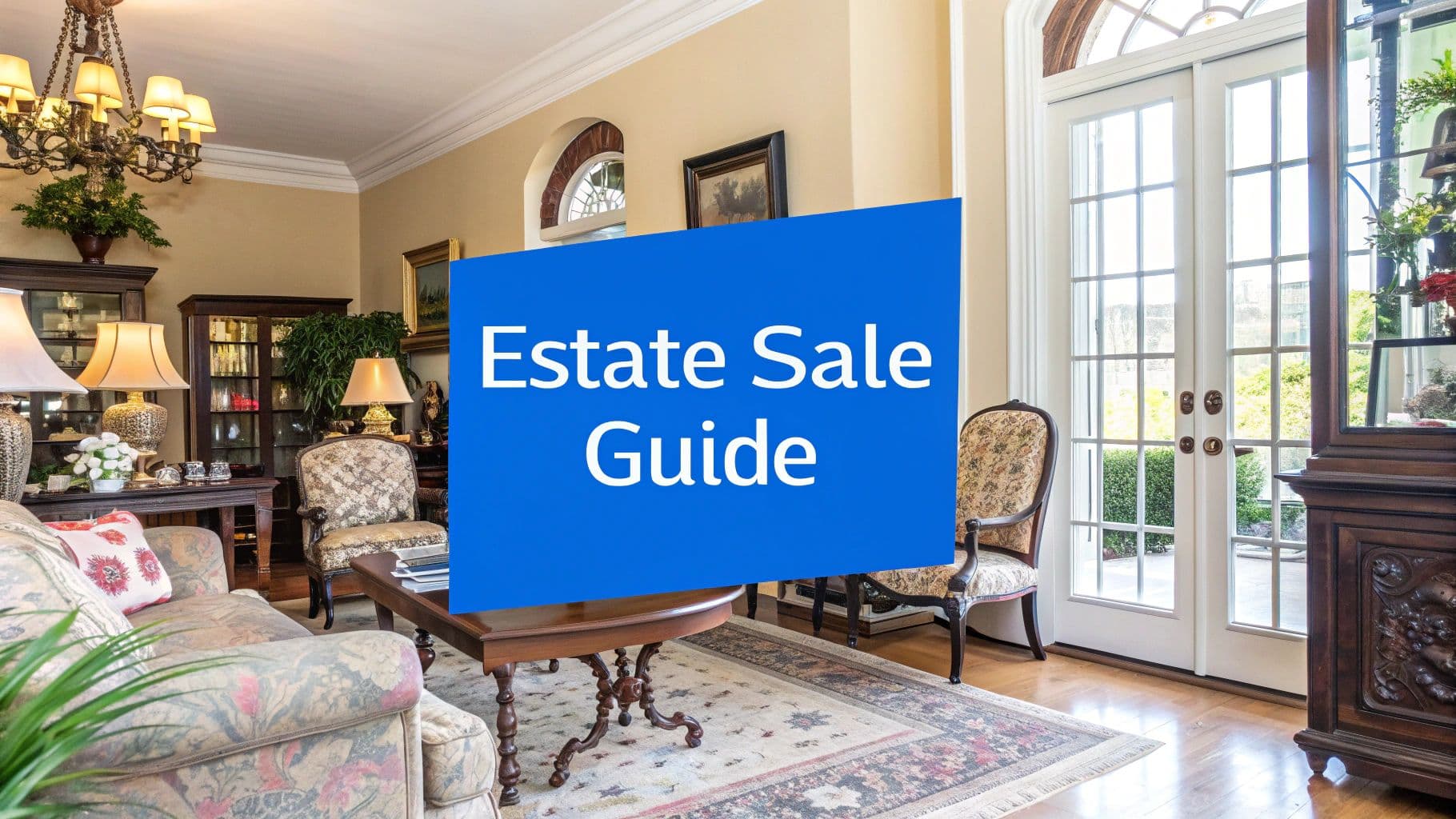
An open house estate sale is a brilliant hybrid event that blends a real estate showing with the sale of personal property. It’s a strategy I’ve seen work wonders, drawing two very different but highly motivated crowds—home buyers and bargain hunters—to the same place at the same time. The result? A vibrant, busy atmosphere that creates buzz for both the house and the items inside. It's simply a smarter way to maximize foot traffic and create a sense of urgency over a single weekend.
Why Combining an Open House with an Estate Sale Just Works
Merging these two events isn't just about convenience; it's a strategic power play. Instead of hosting two separate, smaller events, you’re creating one major occasion that pulls in a much broader, more diverse audience.
Think about it from a practical standpoint. Someone might show up for a vintage armchair and find themselves completely captivated by the home's original hardwood floors. On the flip side, a potential homebuyer could be swayed to make a faster, more serious offer when they see they can also purchase the perfectly-suited patio furniture.
This dual-purpose approach naturally injects excitement and urgency into the air. A steady stream of people moving through the property makes it feel desirable and in high demand—a subtle but powerful psychological edge when it comes to real estate negotiations.
Attracting Two Audiences at Once
The real magic of this approach is that you're casting a much wider net than you would otherwise. You're marketing simultaneously to two key groups:
- Serious Home Buyers: People actively searching for their next home in that specific neighborhood.
- Dedicated Estate Sale Shoppers: Avid bargain hunters, collectors, and resellers always on the lookout for unique finds.
This crossover is where you see the biggest wins. A bargain hunter might not be in the market for a house, but their sister-in-law is. A prospective buyer might have been on the fence, but the ability to buy some of the existing furniture simplifies their move and seals the deal.
Interestingly, while only about 2% of homebuyers traditionally find their home through an open house, these events are still a vital tool for real estate agents. When you add the estate sale element, you dramatically boost the event's overall draw and appeal. You can get more insights on why open houses still pack a punch over at A Brilliant Tribe.
By combining these events, you're not just selling a house or its contents; you're selling a complete, ready-to-move-in vision. This can significantly speed up the entire liquidation process, from the first visitor to the final sale.
This diagram breaks down how a combined event creates a fast track for selling both the property and its contents.
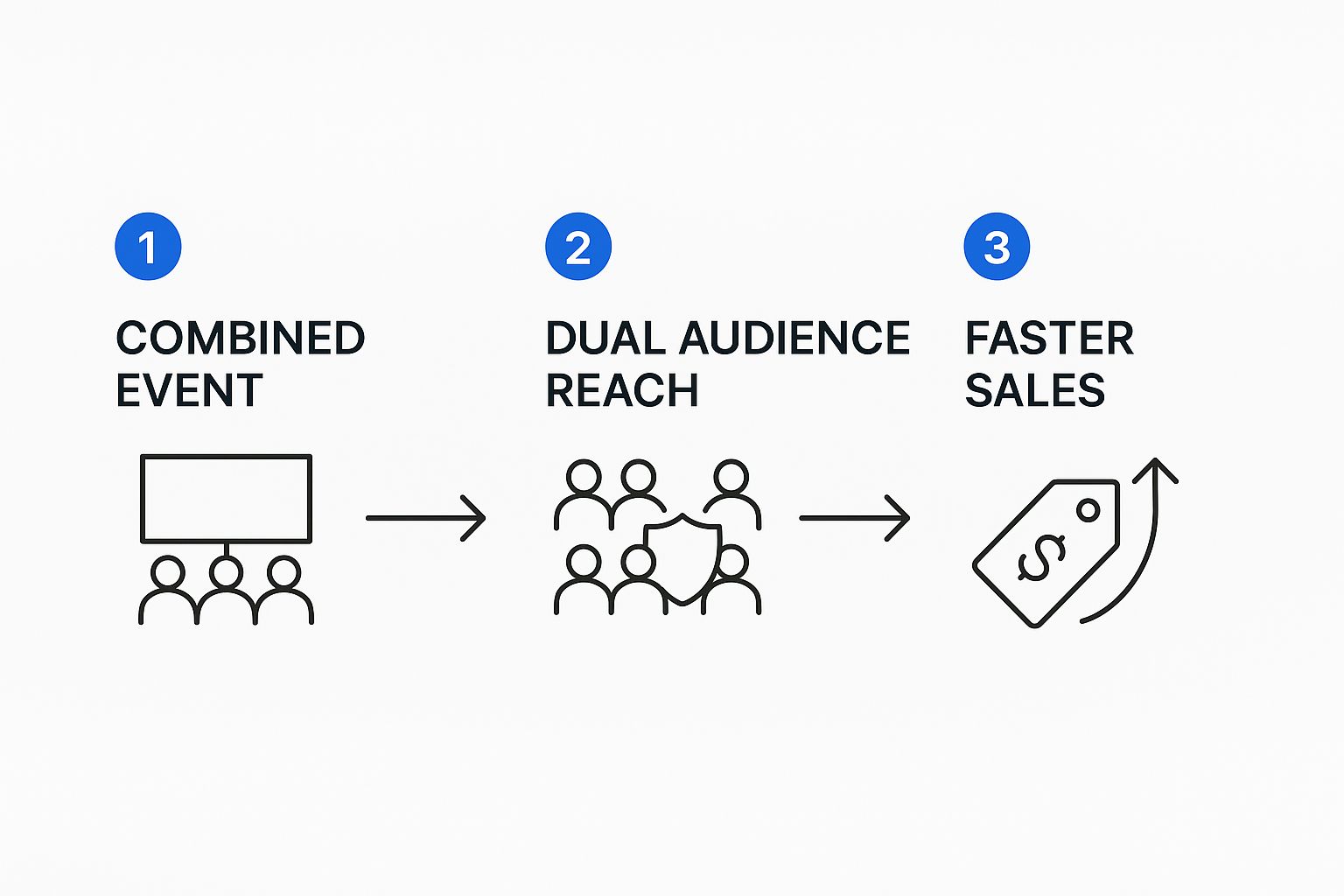
As you can see, a single, well-planned event can create a streamlined path to faster results for both the home and the possessions within it.
Comparing Event Strategies
To really understand the advantage, let's break down how a standalone open house, a standalone estate sale, and a combined event differ. Each serves a purpose, but their synergy is undeniable.
| Event Type | Primary Goal | Target Audience | Key Benefit |
|---|---|---|---|
| Real Estate Open House | Sell the property | Prospective homebuyers & real estate agents | Showcases the home's features and potential |
| Estate Sale | Liquidate personal property | Bargain hunters, collectors, resellers | Efficiently sells a large volume of items |
| Combined Event | Sell both property & items | Homebuyers, estate sale shoppers, neighbors | Creates maximum foot traffic & urgency for both sales |
By looking at them side-by-side, it's clear how the combined strategy leverages the strengths of both, creating a high-energy event that drives results across the board.
Laying the Groundwork for Your Sale
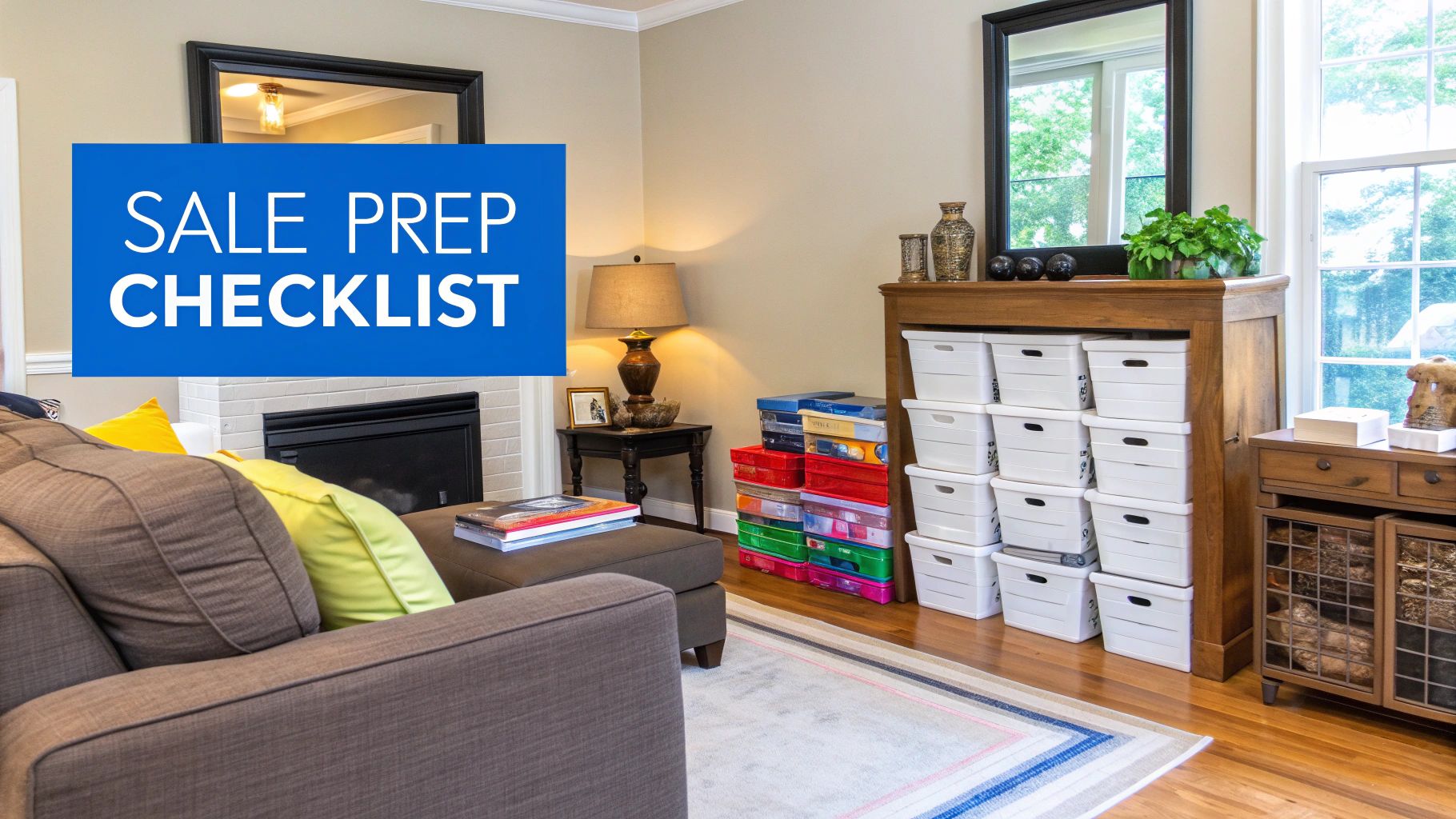
Long before the first potential buyer steps over the threshold, the real work of an estate sale happens. A successful sale isn’t just about putting price tags on things; it's built on a solid foundation of careful sorting, detailed inventorying, and smart planning. Nail this part, and you’ll avoid the overwhelm that sinks so many DIY sales.
The first, and often most emotional, task is simply sorting through everything. You'll need to create distinct piles: items to sell, items to keep, things to donate, and what's just plain trash. If you're tackling a whole house, this can feel daunting. A great resource is this guide on decluttering before a move, which offers a practical system to follow.
This initial sort is non-negotiable. Without it, trying to create an inventory becomes a chaotic mess, and staging the home for buyers is next to impossible.
Build Your Digital Inventory
With your "for sale" items identified, it’s time to create your inventory. Leave the old-school clipboard behind—this is where a tool like the DIYAuctions platform becomes your best friend. The goal is to create a digital catalog of every single item you plan to sell.
A high-quality inventory listing needs three things:
- Great Photos: Use good, natural light and snap pictures from several angles. For a piece of furniture, make sure to capture any unique details or imperfections. Honesty is key.
- Specific Titles: Don't just write "Table." Instead, try "Vintage Oak Farmhouse Dining Table." Specificity sells.
- Honest Descriptions: Note the condition, exact dimensions, and any brand names or interesting history you might know.
This digital catalog is more than just a list; it’s the engine for your entire sale. It helps you track every asset, but it also becomes the backbone of your online marketing and auction management. For a deeper dive into this, check out our complete guide on estate sale planning.
A pro tip for high-value items: set a reserve price during the inventory process. This is the absolute minimum you’ll accept, protecting you from letting a valuable antique go for a fraction of its worth.
Sort Out the Logistics and Timeline
Once your inventory is built, you can shift your focus to the practical details. The two big ones here are legalities and scheduling. You absolutely must check with your local city or county clerk's office about permits. Regulations for hosting an estate sale can vary wildly from one town to the next.
Don't skip this step. Getting hit with a fine or, worse, having your sale shut down is a nightmare scenario. Some homeowner associations (HOAs) also have strict rules about signage, parking, and sale hours, so be sure to check those, too.
Finally, map out a realistic timeline. Start with your sale date and work backward. Giving yourself enough time prevents that last-minute panic and ensures every task gets the attention it needs.
Sample Sale Timeline:
- 4-6 Weeks Out: Begin the big sort and decluttering.
- 3-4 Weeks Out: Start photographing items and building your digital inventory.
- 2-3 Weeks Out: Research local regulations and apply for any needed permits.
- 1-2 Weeks Out: Launch your online promotion and begin staging the home for the open house.
Pricing and Staging for Maximum Returns
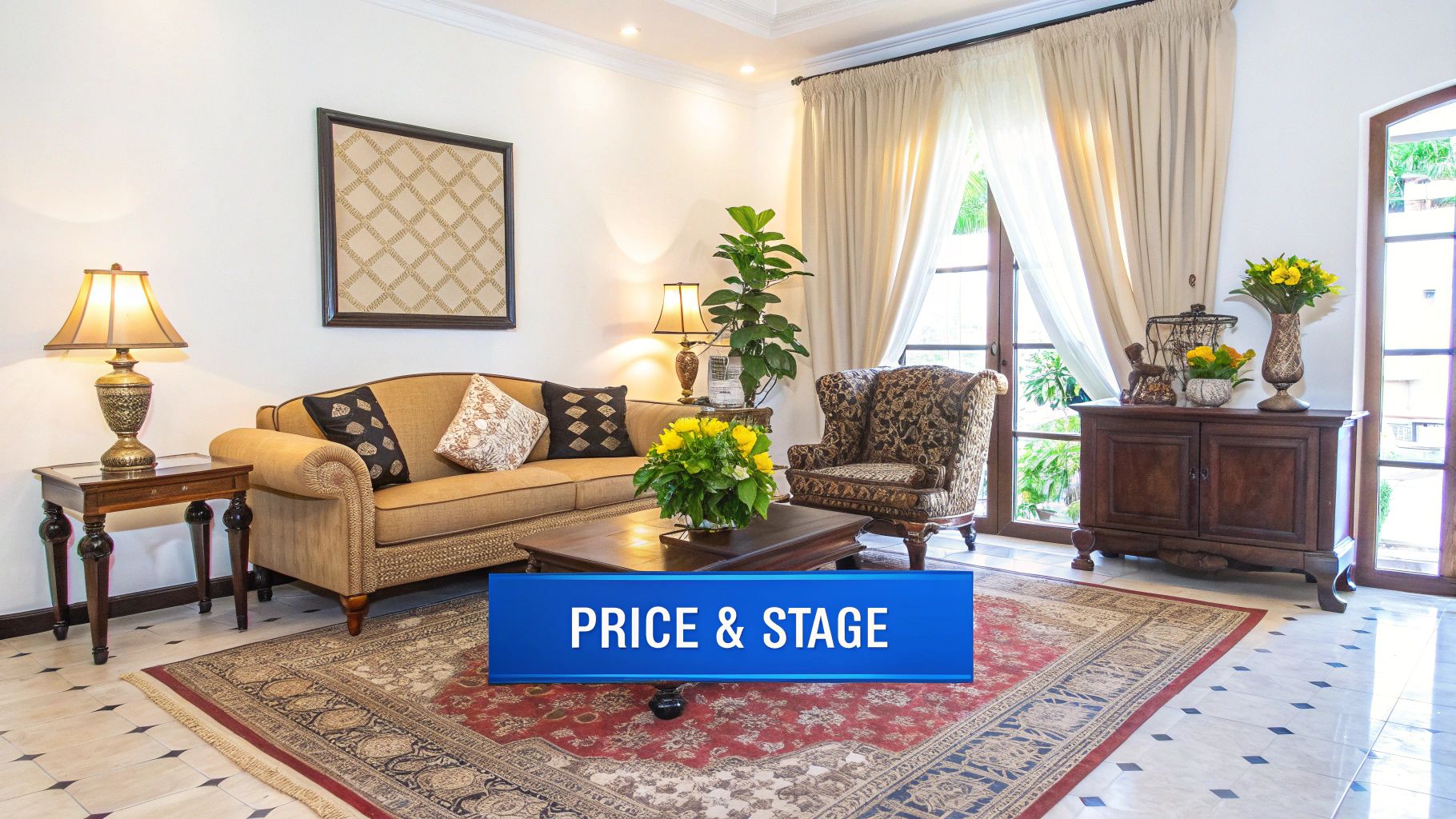
Alright, you've sorted through everything. Now it’s time to focus on the two things that will make or break your sale's profitability: pricing and presentation. Nailing these two elements is how you turn a simple cleanout into a serious money-maker, boosting returns on both the items and the property itself. This is where a little bit of strategy and a good eye come together to create an experience that wows everyone who walks in.
Smart pricing is part art, part science. For those special, high-demand pieces—think mid-century modern furniture or unique art—letting the market decide the price is often your best bet. An auction-style format on your DIYAuctions listing can work wonders here, often driving the final price far higher than any fixed tag you could come up with.
For most everyday household items, though, a simple fixed price is the way to go. The trick is to do your homework. Jump on online marketplaces and see what similar items are actually selling for. If you want to go deeper, our estate sale pricing guide is packed with detailed strategies to help you value everything correctly.
Setting the Stage for Success
Staging is so much more than just tidying up. You're transforming a home into an intuitive, inviting retail space. The goal is twofold: highlight the home's best features for potential real estate buyers while also showcasing the sale items in the best possible light.
First things first, create logical pathways. Group similar items together—put all the kitchen gadgets in the kitchen, line up the tools in the garage. This simple organization makes the shopping experience ten times better for your visitors and prevents them from feeling overwhelmed.
Remember, every person who walks in is a potential buyer of something. A well-staged home makes it easier for them to envision both living in the space and owning the items within it.
Think like a shop owner for a day. Get smaller items off the floor and onto tables or shelves where they're at eye level. And don't forget lighting! Open up the curtains, turn on all the lamps. A bright, warm atmosphere feels welcoming and helps people see the true quality of what you're selling.
Strategic Placement and Flow
How you arrange the sale has a massive impact on how people move through the house and what they end up seeing. Your staging needs to encourage a natural, easy flow from room to room, preventing those awkward bottlenecks in hallways and doorways.
Here are a few practical tips I’ve seen work time and time again:
- Pull furniture off the walls: Even just a few inches can make a room feel significantly larger and more open.
- Highlight the "wow" pieces: Place your most attractive or valuable items where they can't be missed, like right near the entrance or in a well-lit corner.
- Create visual interest: Use books, decor, and textiles to set up small vignettes on tables and shelves. These little displays are great for drawing the eye and showing how items can be used together.
This level of preparation is absolutely critical, especially when you factor in the real estate side. On average, homes can sell within 30 to 90 days, so your open house estate sale needs to make a powerful first impression to capitalize on that short window.
Marketing Your Event to Attract the Right Crowd
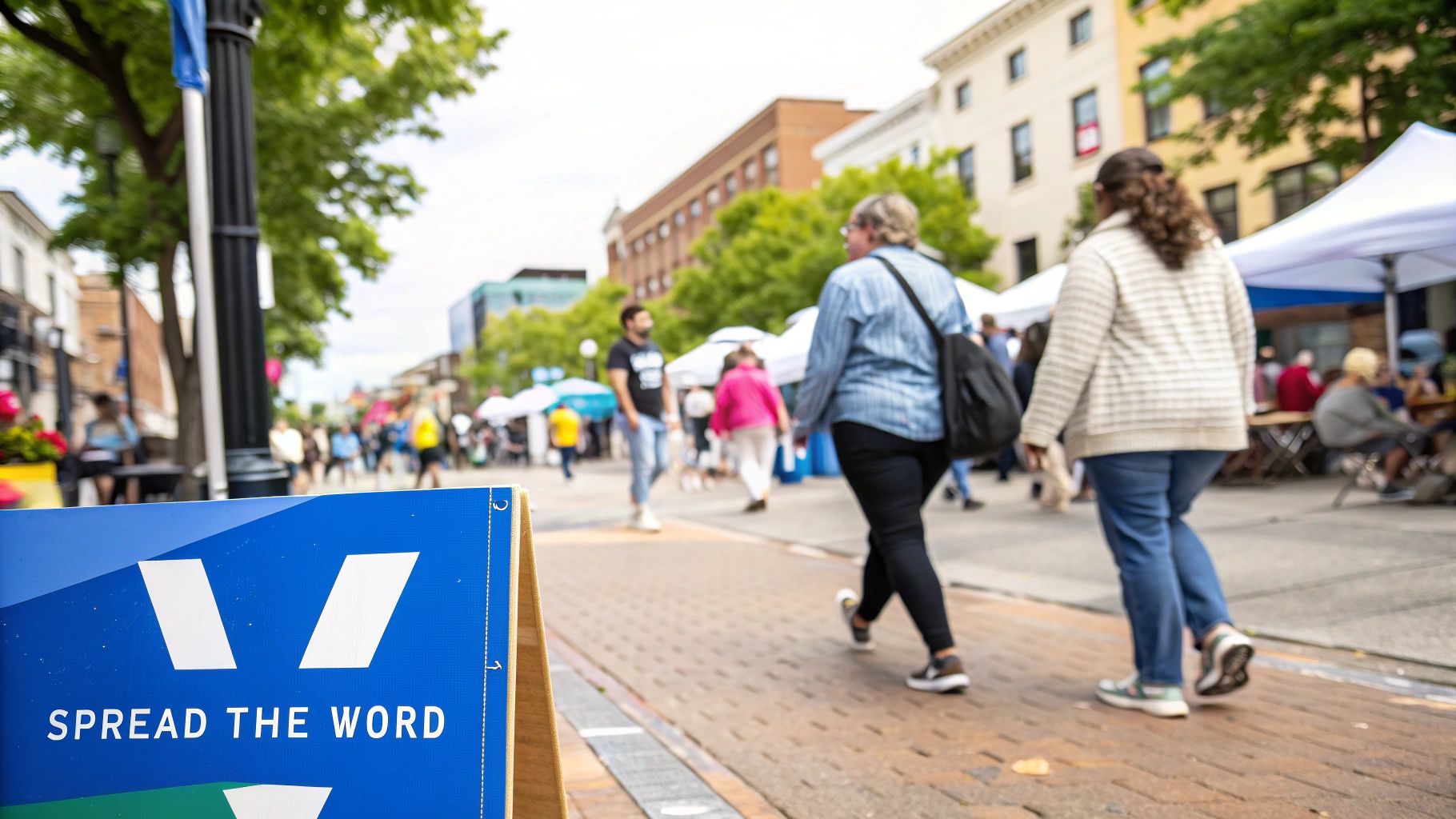
You can stage the most incredible sale, but it means nothing without a crowd. Your marketing is the bridge that connects a house full of treasures to a line of eager shoppers waiting at the door.
The secret is a multi-channel approach. You need to create one unified message that speaks to both potential home buyers and seasoned estate sale shoppers at the same time.
Your digital push should start with compelling online listings. On real estate sites, write descriptions that spotlight the unique open house estate sale format. Frame it as a special opportunity: buyers can tour a beautiful home and purchase its contents for a turnkey moving experience.
At the same time, you have to get the word out to the estate sale community. This is where platforms like DIYAuctions are invaluable—they push your sale directly to a built-in list of qualified local buyers. This dual-platform strategy makes sure you're seen by everyone who might be interested.
Harnessing Social Media and Local Groups
Social media is a fantastic, free tool for creating local buzz. Don't just throw up a few pictures and call it a day. Create an official Facebook Event for your sale. This gives people a central hub to ask questions, see sneak peeks of items, and get automated reminders.
From there, share your event in local community groups, neighborhood pages, and online forums. When you post, focus on what makes your sale stand out:
- Highlight the "Wow" Items: Share great photos of your most interesting pieces, whether it's antique furniture, a cool collection, or high-end electronics.
- Showcase the Home: A few beautiful shots of the property itself will pull in the house-hunting crowd.
- Nail the Details: Every single post should include the full address, sale dates, and hours. No exceptions.
This strategy lets you tap into the massive global real estate market, which is projected to hit $654.40 trillion by 2025. By targeting specific demographics online—like millennials who are jumping into the home-buying market—you can attract a highly motivated crowd.
The beauty of this combined marketing is that every ad dollar and every social media post works twice as hard, promoting both the property and its contents to distinct but overlapping audiences.
Don't Underestimate Old-School Tactics
While a strong online game is essential, you can't forget the power of good old-fashioned signage. Clear, well-placed signs are absolutely non-negotiable for guiding traffic on the day of the sale.
There are many types of effective outdoor business signs that you can adapt for your event. Place large, easy-to-read signs at major intersections nearby, then use smaller directional signs to lead people down the final streets. The goal is to make finding your sale completely effortless.
For a complete playbook on combining digital and physical promotion, check out our detailed guide on estate sale marketing. By blending smart online outreach with effective on-the-ground tactics, you'll build a well-rounded campaign that draws the perfect crowd.
Here we go. The big day is finally here.
All that planning and prep work? This is where it all pays off. When the doors open, your focus shifts from planning to pure execution. A smooth, successful sale day comes down to a solid morning-of routine, smart crowd control, and making sure everyone feels welcome and secure.
Kick things off a few hours before you officially open. Take one last walk through the house. Are all the price tags in place? Is the checkout station ready to go with bags, bubble wrap for the breakables, and a fully charged phone or tablet for payments? Now's the time for that final check.
Assembling Your Sale-Day Team
Let's be real: you can't be in three places at once. That's why having a small, reliable team is a game-changer. This doesn't mean you need to hire professionals—family and friends are often your best asset. The trick is to give everyone a clear job before the first shopper walks in. It keeps the chaos at bay when things inevitably get hectic.
Think about assigning a few key roles:
- The Greeter: Plant this person right at the front door. Their job is to offer a warm welcome, quickly explain the rules (like "restrooms are for paying customers only" or "the upstairs is off-limits"), and keep the flow of people moving smoothly.
- Floor Rovers: You'll want one or two people meandering through the sale. They can answer questions, straighten up displays that get messy, and generally act as a helpful presence.
- Checkout Pro: This person needs to be comfortable handling money and running your payment system. They're the last point of contact for your buyers, so a friendly, efficient checkout is key.
When everyone knows their role, it creates a much more professional vibe and ensures shoppers can always find someone to help. Plus, having friendly faces visible throughout the house is a huge deterrent for potential theft.
Keeping the Crowd and Checkout Moving
A good sale is a busy sale, and that means managing the crowd is your top priority. Your greeter at the door can act as a gatekeeper, letting people in at a steady pace to prevent the home from becoming a fire hazard. That first hour is usually a madhouse, so this is especially important right at the start.
The single biggest holdup at any sale is always the checkout line. A slow, clunky payment process is frustrating for everyone and can make the whole event feel disorganized. In this day and age, you absolutely have to accept credit cards, debit, and mobile payments.
A fast, seamless checkout experience does more than just keep the line short. It leaves buyers with a great final impression, making them more likely to tell their friends about your sale.
The DIYAuctions system makes this part easy, automatically tracking every purchase and handling all the payments securely. No more wrestling with a cash box or trying to decipher handwritten sales records.
Safety and Security Are Non-Negotiable
Finally, you have to keep the environment safe and secure. Before anyone arrives, lock any doors to rooms that are off-limits and put up clear "Do Not Enter" signs. More importantly, get any personal valuables, prescription medications, or sensitive documents completely out of the house.
During the sale, your floor rovers double as your security team. Just by being present and visible, they discourage most opportunistic shoplifters. For those small, high-value items like jewelry or collectibles, it’s a smart move to keep them in a locked display case right by the checkout counter where they can be watched closely.
By finding that perfect balance between a welcoming vibe and basic, common-sense security, you can make sure your open house estate sale is not just profitable, but also a stress-free success.
What to Do After the Doors Close
The moment the last buyer walks out and you finally lock the door, it’s tempting to collapse and call it a day. And while the hardest part is definitely over, a few smart moves right after the sale will make all the difference. This is how you wrap up a truly successful event and pivot back to selling the house.
Your first job is to deal with what’s left. It’s totally normal for some things not to sell. The key is having a plan in place so you can get the house completely cleared out and ready for its real estate debut.
Managing Unsold Items
After a long, exhausting sale, facing a house that's still got stuff in it can feel overwhelming. But you don't have to just call a junk hauler and be done with it. You can still squeeze a little more value out of what's left.
I always recommend a tiered approach. Work in this order:
- Consignment for High-Value Pieces: Did that gorgeous antique dresser or that cool piece of art not get the bids it deserved? Don't lose hope. Local consignment shops are perfect for finding the right home for high-quality items that just need a more specific audience.
- Charitable Donations: For everything else that’s still in good shape—think kitchen gadgets, books, clothes—donating is a great option. A lot of charities will even come and pick it all up, which is a huge time-saver. Don't forget to grab a receipt for a possible tax write-off!
- Final Clean-Out Service: Okay, once the best stuff is at the consignor and the good stuff is with the charity, it's time to clear out the rest. A professional clean-out or junk removal service can come in and handle whatever is left. This is the final step to getting the property completely empty and broom-swept clean.
By tackling it this way, you maximize your returns, give back to the community, and then efficiently clear out the last bits with professional help. It's all about working smarter, not harder.
Financial Wrap-Up and Analysis
With the house finally empty, it's time to look at the numbers. Honestly, this is where a platform like DIYAuctions becomes your best friend. All the heavy lifting is already done. Your dashboard has a perfect record of every single sale, so there's no frantic guesswork or missing receipts.
Your main goal is to figure out your final net profit. Just take your total gross sales and subtract the expenses you paid for—things like permit fees, the cost of your signs, or the final clean-out crew. That simple math will give you the real story of how well your sale did.
Pivoting Back to the Real Estate Sale
Now for the most important part. It's time to switch gears back to the main event: selling the house itself. Your open house estate sale didn't just sell items; it brought a ton of potential homebuyers through the door.
This is the moment to connect with your real estate agent. Hand over that sign-in sheet with the names of everyone who seemed genuinely interested in the property, not just the possessions. You've just given your agent a pre-qualified list of warm leads to follow up with immediately. By making this a seamless transition, you ensure that all the traffic and excitement you generated doesn't go to waste.